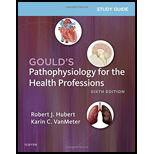
a.
To describe: The characteristics and role of nociceptor in the pain pathway.
Concept introduction: The distressing feeling that is caused by the intense or by harmful stimuli is known as pain. Pain is the important function of the nervous system in supplying the body with a warning of potential injury. It is considered as the sensory as well as the emotional experience. The pain pathway explains about the transmission of pain stimulus from the place of origin to the brain.
b.
To describe: The characteristics and role of C fibers in the pain pathway.
Concept introduction: The distressing feeling that is caused by the intense or by harmful stimuli is known as pain. Pain is the important function of the nervous system in supplying the body with a warning of potential injury. It is considered as the sensory as well as the emotional experience. The pain pathway explains about the transmission of pain stimulus from the place of origin to the brain.
c.
To describe: The characteristics and role of spinothalamic tract in the pain pathway.
Concept introduction: The distressing feeling that is caused by the intense or by harmful stimuli is known as pain. Pain is the important function of the nervous system in supplying the body with a warning of potential injury. It is considered as the sensory as well as the emotional experience. The pain pathway explains about the transmission of pain stimulus from the place of origin to the brain.
d.
To describe: The characteristics and role of parietal lobe in the pain pathway.
Concept introduction: The distressing feeling that is caused by the intense or by harmful stimuli is known as pain. Pain is the important function of the nervous system in supplying the body with a warning of potential injury. It is considered as the sensory as well as the emotional experience. The pain pathway explains about the transmission of pain stimulus from the place of origin to the brain.
e.
To describe: The characteristics and role of reticular formation in the pain pathway.
Concept introduction: The distressing feeling that is caused by the intense or by harmful stimuli is known as pain. Pain is the important function of the nervous system in supplying the body with a warning of potential injury. It is considered as the sensory as well as the emotional experience. The pain pathway explains about the transmission of pain stimulus from the place of origin to the brain.
f.
To describe: The characteristics and role of endorphins and enkephalins in the pain pathway.
Concept introduction: The distressing feeling that is caused by the intense or by harmful stimuli is known as pain. Pain is the important function of the nervous system in supplying the body with a warning of potential injury. It is considered as the sensory as well as the emotional experience. The pain pathway explains about the transmission of pain stimulus from the place of origin to the brain.
Want to see the full answer?
Check out a sample textbook solution
Chapter 4 Solutions
EBK STUDY GUIDE FOR GOULD'S PATHOPHYSIO
- true or false any practice employee is authorized to and should communicate collection guidelines with practice?arrow_forwardrtrue or false equesting a listing of specific creditreferences during patient intake os an acceptable business practice?arrow_forwardgive an overview on the respiratory assessmentarrow_forward
- explain an abdominal exam?arrow_forwardDiscuss β -Lactam antibiotics under the following subheadings Classifications of penicillins Classification of Cephalosporins General Mechanism of Actions Clinical Indications of penicillins and cephalosporins Adverse effects of β-lactamsarrow_forwarda. Define neoplasm b. Differentiate between benign and malignant tumours c. Describe the molecular basis of cancerarrow_forward
- differentiate the extra heart sounds S3,S4, murmurs and gallopsarrow_forward• Define shock and list types of shock • Discuss pathogenesis of septic shock. • Enumerate the stages of shock. • Define oedema and describe the pathophysiologic mechanisms of oedema with examples.arrow_forwardDiscuss Hypertension under the following headings: Definition Diagnosis Non-pharmacological intervention Drugs Classification Management of a Hypertensive emergencyarrow_forward
- Explain how the answer could be 2 or 1.8 WITHOUT changing the questionarrow_forwardoverview of the neurological system, cranial nerves and what part of the body it innervatesarrow_forwarddifferentiate structure and function of the peripheral vascular system. what are the normal and abnormal findings of the peripheral arterioles and peripheral venous systemarrow_forward
 Phlebotomy EssentialsNursingISBN:9781451194524Author:Ruth McCall, Cathee M. Tankersley MT(ASCP)Publisher:JONES+BARTLETT PUBLISHERS, INC.
Phlebotomy EssentialsNursingISBN:9781451194524Author:Ruth McCall, Cathee M. Tankersley MT(ASCP)Publisher:JONES+BARTLETT PUBLISHERS, INC. Gould's Pathophysiology for the Health Profession...NursingISBN:9780323414425Author:Robert J Hubert BSPublisher:Saunders
Gould's Pathophysiology for the Health Profession...NursingISBN:9780323414425Author:Robert J Hubert BSPublisher:Saunders Fundamentals Of NursingNursingISBN:9781496362179Author:Taylor, Carol (carol R.), LYNN, Pamela (pamela Barbara), Bartlett, Jennifer L.Publisher:Wolters Kluwer,
Fundamentals Of NursingNursingISBN:9781496362179Author:Taylor, Carol (carol R.), LYNN, Pamela (pamela Barbara), Bartlett, Jennifer L.Publisher:Wolters Kluwer, Fundamentals of Nursing, 9eNursingISBN:9780323327404Author:Patricia A. Potter RN MSN PhD FAAN, Anne Griffin Perry RN EdD FAAN, Patricia Stockert RN BSN MS PhD, Amy Hall RN BSN MS PhD CNEPublisher:Elsevier Science
Fundamentals of Nursing, 9eNursingISBN:9780323327404Author:Patricia A. Potter RN MSN PhD FAAN, Anne Griffin Perry RN EdD FAAN, Patricia Stockert RN BSN MS PhD, Amy Hall RN BSN MS PhD CNEPublisher:Elsevier Science Study Guide for Gould's Pathophysiology for the H...NursingISBN:9780323414142Author:Hubert BS, Robert J; VanMeter PhD, Karin C.Publisher:Saunders
Study Guide for Gould's Pathophysiology for the H...NursingISBN:9780323414142Author:Hubert BS, Robert J; VanMeter PhD, Karin C.Publisher:Saunders Issues and Ethics in the Helping Professions (Min...NursingISBN:9781337406291Author:Gerald Corey, Marianne Schneider Corey, Cindy CoreyPublisher:Cengage Learning
Issues and Ethics in the Helping Professions (Min...NursingISBN:9781337406291Author:Gerald Corey, Marianne Schneider Corey, Cindy CoreyPublisher:Cengage Learning





